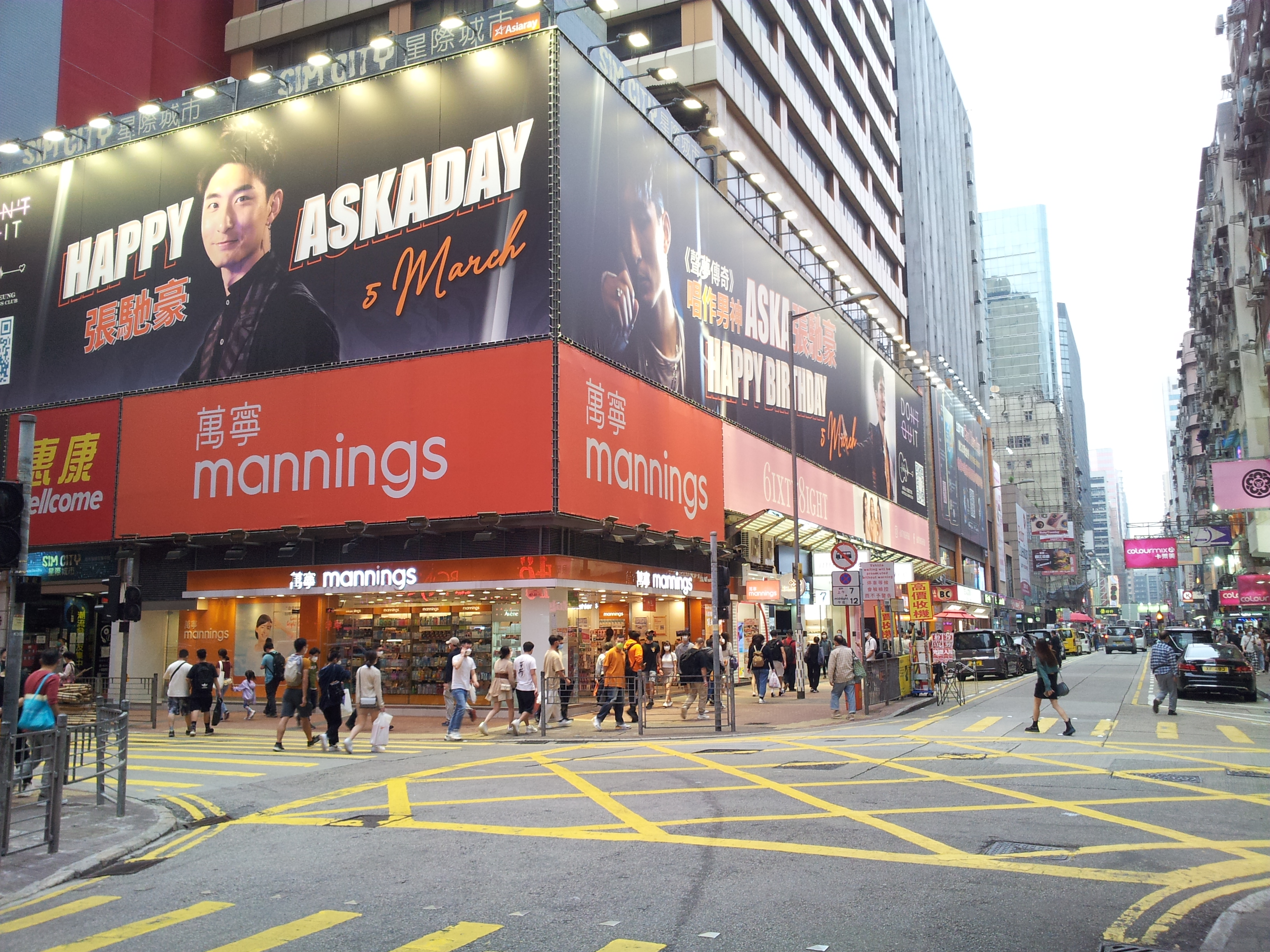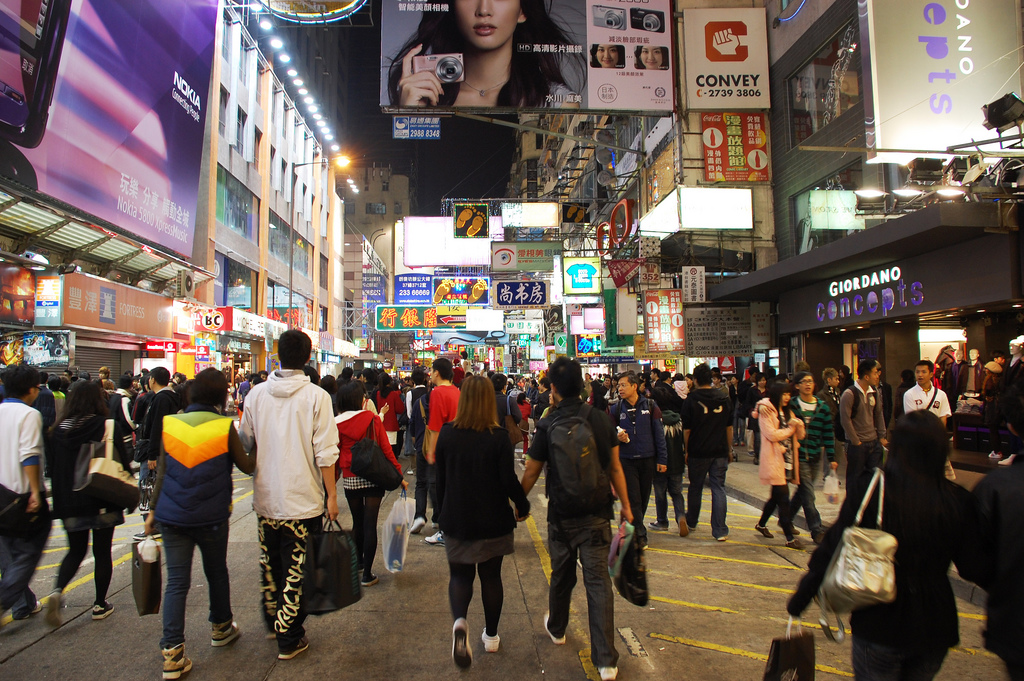Sai Yeung Choi Street South on:
[Wikipedia]
[Google]
[Amazon]
Sai Yeung Choi Street () are two streets in

 Starting from
Starting from
Mong Kok
Mong Kok (also spelled Mongkok, often abbreviated as MK) is an area in Kowloon, Hong Kong. The Prince Edward subarea occupies the northern part of Mong Kok.
Mong Kok is one of the major shopping areas in Hong Kong. The area is characterised ...
, Kowloon
Kowloon () is an urban area in Hong Kong comprising the Kowloon Peninsula and New Kowloon. With a population of 2,019,533 and a population density of in 2006, it is the most populous area in Hong Kong, compared with Hong Kong Island and ...
, Hong Kong, namely, Sai Yeung Choi Street South (西洋菜南街) and Sai Yeung Choi Street North (西洋菜北街). Although officially two streets, local people seldom make distinction between them. They are separated by the Mong Kok Police Station
Mong may refer to:
People
*A proposed original name for the Hmong people, based on the main group, the Mong community
*Bob Mong (), American journalist and academic administrator
*Henry Mong (), American surgeon and Presbyterian missionary
*Mong ...
. Sai Yeung Choi Street South is a popular hotspot for shopping and a tourist attraction.
History
The streets were built onwatercress
Watercress or yellowcress (''Nasturtium officinale'') is a species of aquatic flowering plant in the cabbage family Brassicaceae.
Watercress is a rapidly growing perennial plant native to Europe and Asia. It is one of the oldest known leaf v ...
cultivation in a village, Mong Kok Tsuen (旺角村), in Mong Kok in 1924. The name Sai Yeung Choi is the Chinese name of watercress. As time went by, the village and fields were replaced by high-rise buildings. When the police station was built, the street was separated into two sections. In the late 1970s the Postmaster General suggested renaming the streets, appending "south" and "north", to reduce confusion. On 12 January 1979, the streets were renamed.
In the 1970s, some buildings on Sai Yeung Choi Street were demolished to make way for construction of the Mass Transit Railway.
Sai Yeung Choi Street has been the site of several criminal acts of objects and fluids being thrown from buildings. On 13 December 2008, two bottles of corrosive liquid were hurled from buildings, burning 46 people. On 16 May 2009, two bottles of corrosive liquid were thrown, injuring 30 people. The police increased the award for information leading to an arrest, while the Yau Tsim Mong District Council installed a CCTV system to help catch the perpetrator. A third acid attack occurred on 8 June 2009, injuring 24. A similar attack occurred on 9 January 2010 on nearby Temple Street. On 10 June 2014, a pedestrian was killed on Sai Yeung Choi Street after being hit by a swivel chair thrown from a rooftop by a mentally-ill Mainland Chinese
Mainland Chinese or Mainlanders are Chinese people who live in or have recently emigrated from mainland China, defined as the territory governed by the People's Republic of China (PRC) except for Hong Kong ( SAR of the PRC), Macau (SAR of the PRC), ...
who had been drinking.
Sai Yeung Choi Street was a frequent site of demonstrations during the protracted 2014 Hong Kong protests
A series of sit-in street protests, often called the Umbrella Revolution and sometimes used interchangeably with Umbrella Movement, or Occupy Movement, occurred in Hong Kong from 26 September to 15 December 2014.
The protests began after t ...
.
Sai Yeung Choi Street South

 Starting from
Starting from Dundas Street
Dundas Street is a major historic arterial road in Ontario, Canada. The road connects the city of Toronto with its western suburbs and several cities in southwestern Ontario. Three provincial highways— 2, 5, and 99—followed long section ...
in Yau Ma Tei
Yau Ma Tei is an area in the Yau Tsim Mong District in the south of the Kowloon Peninsula in Hong Kong.
Name
''Yau Ma Tei'' is a phonetic transliteration of the name (originally written as ) in Cantonese. It can also be spelt as Yaumatei, ...
, it runs north and meets major roads, Argyle Street and Mong Kok Road
Mong may refer to:
People
*A proposed original name for the Hmong people, based on the main group, the Mong community
*Bob Mong (), American journalist and academic administrator
* Henry Mong (), American surgeon and Presbyterian missionary
*Mong ...
, and ends at the junction with Prince Edward Road West. This street is a hot spot for Hong Kong people. The section south of Argyle Street concentrates shops of electronic products at street level and ''upstair bookstores'' above.
The busiest portion of the street was pedestrianised
Pedestrian zones (also known as auto-free zones and car-free zones, as pedestrian precincts in British English, and as pedestrian malls in the United States and Australia) are areas of a city or town reserved for pedestrian-only use and in whi ...
all week long in 2000. However, the Traffic and Transport Committee of the Yau Tsim Mong District Council voted on 21 November 2013 to restrict the pedestrianisation to weekends and public holidays only, citing complaints from local residents. A survey conducted by the Home Affairs Department
The Home Affairs Department is an executive agency in the government of Hong Kong responsible for internal affairs of the territory. It reports to the Home and Youth Affairs Bureau, headed by the Secretary for Home Affairs.
Purpose
The D ...
found that 80 per cent of residents and shop owners wanted to limit pedestrianisation, while most people questioned on the street wanted to keep the weekday pedestrianisation. In spite of criticism, the pedestrianisation hours were reduced to weekends only with effect from January 2014. The section of the street between Argyle Street and Dundas Street was closed to motorised traffic from 4:00 pm to 10:00 pm on Saturdays, and noon to 10:00 pm on Sundays and public holidays. Retail rents on the street subsequently dropped.
The noise of street performers has increasingly become a point of contention at Sai Yeung Choi Street South, as at certain other locations in Hong Kong (e.g. Tuen Mun Park). As such public singing and dancing is common in Mainland Chinese squares and parks, Hong Kong media have called the phenomenon an example of the " mainlandisation" of Hong Kong. The "often-off-key singing blasting from the loudspeakers" is considered excessively loud and lacking in artistic merit. A study commissioned by the Liberal Party
The Liberal Party is any of many political parties around the world. The meaning of ''liberal'' varies around the world, ranging from liberal conservatism on the right to social liberalism on the left.
__TOC__ Active liberal parties
This is a li ...
found that noise levels on Saturday nights reached 101.5 decibels. In 2017, authorities received more than 1,200 complaints about the performers, who are not managed by any licensing or regulatory system. In response to pressure from residents and businesses, the Yau Tsim Mong District Council voted in May 2018 to temporarily suspend the pedestrianisation scheme, and the pedestrian zone ceased to exist at 10pm on 29 July 2018.
Sai Yeung Choi Street North
Starting from Playing Field Road, it runs north, crossingBoundary Street
Boundary Street is a three-lane one-way street in Kowloon, Hong Kong. It runs in an easterly direction from its start at the intersection with Tung Chau Street in the west, and ends at its intersection with Prince Edward Road West in t ...
into New Kowloon
New Kowloon is an area in Hong Kong, bounded in the south by Boundary Street, and in the north by the ranges of the Eagle's Nest, Beacon Hill, Lion Rock, Tate's Cairn and Kowloon Peak. It covers the present-day Kwun Tong District and Wong T ...
and terminates slight beyond Poplar Street. This street is largely residential and more quiet than the other street in the south. A much shorter, separated section of this street is to the north, between Sai Yeung Choi Lane and St. Francis' Church, separated by a hill slope.
Transportation
* Mong Kok station (Exits B2, B3, D2, D3, E2) *Prince Edward station
Prince Edward is a station of the MTR rapid transit system in Hong Kong. It is located in Mong Kok, Kowloon, under the intersection of Nathan Road and Prince Edward Road West. The station is named after this road.
History
As Prince Edward ...
(Exits A, B2)
See also
*List of streets and roads in Hong Kong
The following are incomplete lists of notable expressways, tunnels, bridges, roads, avenues, streets, crescents, squares and bazaars in Hong Kong.
Many roads on the Hong Kong Island conform to the contours of the hill landscape. Some of the ...
References
{{Coord, 22.32195, 114.16944, display=title Mong Kok Roads in Kowloon